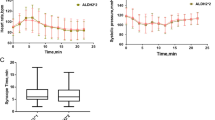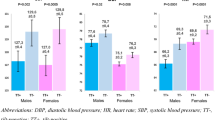Abstract
Introduction
Genetics may be involved in the pathophysiology of vasovagal syncope. The 3A/4A polymorphism of the EDN1 gene affects the expression of endothelin-1, and the H323H T/C polymorphism of the EDNRA gene encoding for the endothelin type A receptor has been associated with cardiovascular pathologies. As the endothelin system participates in the regulation of cardiovascular homeostasis, the aim of this study was to analyse the role of these genetic variants in influencing tilt-induced vasovagal syncope.
Materials and methods
We recorded the cardiovascular parameters of 107 otherwise healthy subjects with recurrent unexplained syncope who underwent a head-up tilt test; 58 (54%) fainted.
Results
In terms of the EDNRA polymorphism, eight subjects (8%) had the T/T genotype, 41 were heterozygous (38%) and 58 homozygous (54%) for the C allele. Sixty subjects (56%) carried homozygosis for the 3A allele of the EDN1 polymorphism and 47 were heterozygous (44%). The 4A allele was significantly more frequent in the patients who responded positively to the tilt test than in those who did not: the relative odds ratios and confidence intervals at univariate and multivariate analyses were respectively 2.37 (1.07–5.26) and 2.41 (1.05–5.49). Comparisons with a control group further supported these data. Among the tilt-positive patients, the carriers of the 4A allele were more likely to have a vasodepressive pattern than those who were homozygous for the 3A variant.
Conclusion
In conclusion, the 3A/4A polymorphism of the EDN1 gene affects susceptibility to syncope, and the 4A variant associated with increased endothhelin-1 expression may promote vasodepressive hemodynamic responses during tilt testing.
Similar content being viewed by others
References
Agapitov AV, Haynes WG (2002) Role of endothelin in cardiovascular disease. JRAAS 3:1–15
Arai H, Hori S, Aramori I et al (1990) Cloning and expression of a cDNA encoding an endothelin receptor. Nature 348:730–732
Brignole M, Alboni P, Benditt DG et al (2004) Task force on syncope, European Society of Cardiology. Guidelines on management (diagnosis and treatment) of syncope—update. Europace 6:467–537
Brunner F, Bràs-Silva C, Cerdeira AS et al (2006) Cardiovascular endothelins: essential regulators of cardiovascular homeostasis. Pharmacol Ther 111:508–531
Colombo MG, Ciofini E, Paradossi E et al (2006) ET-1 Lys198Asn and ET(A) receptor H323H polymorphisms in heart failure. A case-control study. Cardiology 105:246–252
Diefenbach K, Arjomand-Nahad F, Meisel C et al (2006) Systematic analysis of sequence variability of the Endothelin-1 gene: a prerequisite for association studies. Genet Test 10:163–168
Forleo C, Sorrentino S, Guida P et al (2007) β1- and β2-adrenergic receptor polymorphisms affect susceptibility to idiopathic dilated cardiomyopathy. J Cardiovasc Med (Hagerstown) 8:589–595
Fortin J, Habenbacher W, Gruellenberger R et al. (1998) Real-time monitor for hemodynamic beat-to-beat parameters and power spectral analysis of the biosignals. In: Proceedings of the 20th Annual International Conference of the IEEE Engineering in Medicine and Biology Society, vol. 20, no. 1, Piscataway NJ, IEEE Computer Society Press
Fortin J, Habenbacher W, Heller A et al (2006) Non-invasive beat-to-beat cardiac output monitoring by an improved method of transthoracic bioimpedance measurement. Comput Biol Med 36:1185–1203
Gratze G, Fortin J, Holler A et al (1998) A software package for non-invasive, real-time beat-to-beat monitoring of stroke volume, blood pressure, total peripheral resistance and for assessment of autonomic function. Comput Biol Med 28:121–142
Haynes WG, Webb DJ (1998) Endothelin as a regulator of cardiovascular function in health and disease. J Hypertens 16:1081–1098
Herrmann S, Schmidt-Petersen K, Pfeifer J et al (2001) A polymorphism in the endothelin—a receptor gene predicts survival in patients with idiopathic dilated cardiomyopathy. Eur Heart J 22:1948–1953
Iacoviello M, Guida P, Forleo C et al (2008) Impaired arterial baroreflex function before nitrate-induced vasovagal syncope during head-up tilt test. Europace 10:1170–1175
Inoue A, Yanagisawa M, Kimura S et al (1989) The human endothelin family: three structurally and pharmacologically distinct isopeptides predicted by three separate genes. Proc Natl Acad Sci 86:2863–2867
Kaufmann H, Oribe E, Oliver JA (1991) Plasma endothelin during upright tilt: relevance for orthostatic hypotension? Lancet 338:1542–1545
Kuwaki T, Kurihara H, Cao WH et al (1997) Physiological role of brain endothelin in the central autonomic control: from neuron to knockout mouse. Prog Neurobiol 51:545–579
Lelonek M, Pietrucha T, Matyjaszczyk M et al (2008) Mutation T/C, Ile 131 of the gene encoding the alfa subunit of the human Gs protein and predisposition to vasovagal syncope. Circ J 72:558–562
Lelonek M, Pietrucha T, Matyjaszczyk M et al (2008) C825T G-protein β3 subunit gene polymorphism, tilt test results and point score in syncopal patients. Clin Autonom Res 18:158–161
Lillie EO, Mahata M, Khandrika S et al (2007) Heredity of endothelin secretion. Human twin studies reveal the influence of polymorphism at the chromogranin A locus, a novel determinant of endothelial function. Circulation 115:2282–2291
Magerkurth C, Riedel A, Braune S (2005) Permanent increase in endothelin serum levels in vasovagal syncope. Clin Auton Res 15:299–301
Makita T, Suchov HM, Gariepy CE et al (2008) Endothelins are vascular-derived axonal guidance cues for developing sympathetic neurons. Nature 452:759–763
Màrquez MF, Hernàndez-Pacheco G, Hermosillo AG et al (2007) The Arg389Gly beta1-adrenergic receptor gene polymorphism and susceptibility to faint during head-up tilt test. Europace 9:585–588
Mehta M, Wolff G, Young ML et al (1995) Usefulness of endothelin-1 as a predictor of response to head-up tilt-table testing in children with syncope. Am J Cardiol 76:86–88
Newton JL, Donaldson P, Parry S et al (2005) Angiotensin converting enzyme insertion/deletion polymorphisms in vasovagal syncope. Europace 7:396–399
Newton JL, Kenny R, Lawson J et al (2003) Prevalence of family history in vasovagal syncope and haemodynamic response to head up tilt in first degree relatives: preliminary data for the Newcastle cohort. Clin Auton Res 13:22–26
Perna GP, Ficola U, Salvatori MP et al (1990) Increase of plasma beta endorphins in vasodepressor syncope. Am J Cardiol 65:929–930
Popowski K, Sperker B, Kroemer HK et al (2003) Functional significance of a hereditary adenine insertion variant in the 5’-UTR of the endothelin-1 gene. Pharmacogenetics 13:445–451
Riegger GA, Wagner A (1991) Excessive secretion of vasopressin during vasovagal reaction. Am Heart J 121:602–603
Samoil D, Grubb BP (1995) Neurally mediated syncope and serotonin reuptake inhibitors. Clin Auton Res 5:251–255
Sra JS, Murthy V, Natale A et al (1994) Circulatory and catecholamine changes during head-up tilt testing in neurocardiogenic (vasovagal) syncope. Am J Cardiol 73:33–37
Tanaka C, Kamide K, Takiuchi S et al (2004) Evaluation of the Lys198Asn and -134delA genetic polymorphisms of the endothelin-1 gene. Hypertens Res 27:367–371
White M, Cernacek P, Courtemanche M et al (1998) Impaired endothelin-1 release in tilt-induced syncope. Am J Cardiol 81:460–464
Yanagisawa M, Kurihara H, Kimura S et al (1988) A novel potent vasoconstrictor peptide produced by vascular endothelial cells. Nature 332:411–415
Yanagisawa M, Masaki T (1989) Molecular biology and biochemistry of the endothelins. Trends Pharmacol Sci 10:374–378
Acknowledgments
The authors would like to thank Dr. Luciana D’Alonzo, Mr. Cataldo Balducci, Mrs. Margherita Sarlo and Mrs. Mariella Vitone for their helpful cooperation. This study was partially supported by grants from the University of Bari.
Author information
Authors and Affiliations
Corresponding author
Additional information
S. Sorrentino and C. Forleo contributed equally to this paper.
Rights and permissions
About this article
Cite this article
Sorrentino, S., Forleo, C., Iacoviello, M. et al. Endothelin system polymorphisms in tilt test-induced vasovagal syncope. Clin Auton Res 19, 347–354 (2009). https://doi.org/10.1007/s10286-009-0008-3
Received:
Accepted:
Published:
Issue Date:
DOI: https://doi.org/10.1007/s10286-009-0008-3




